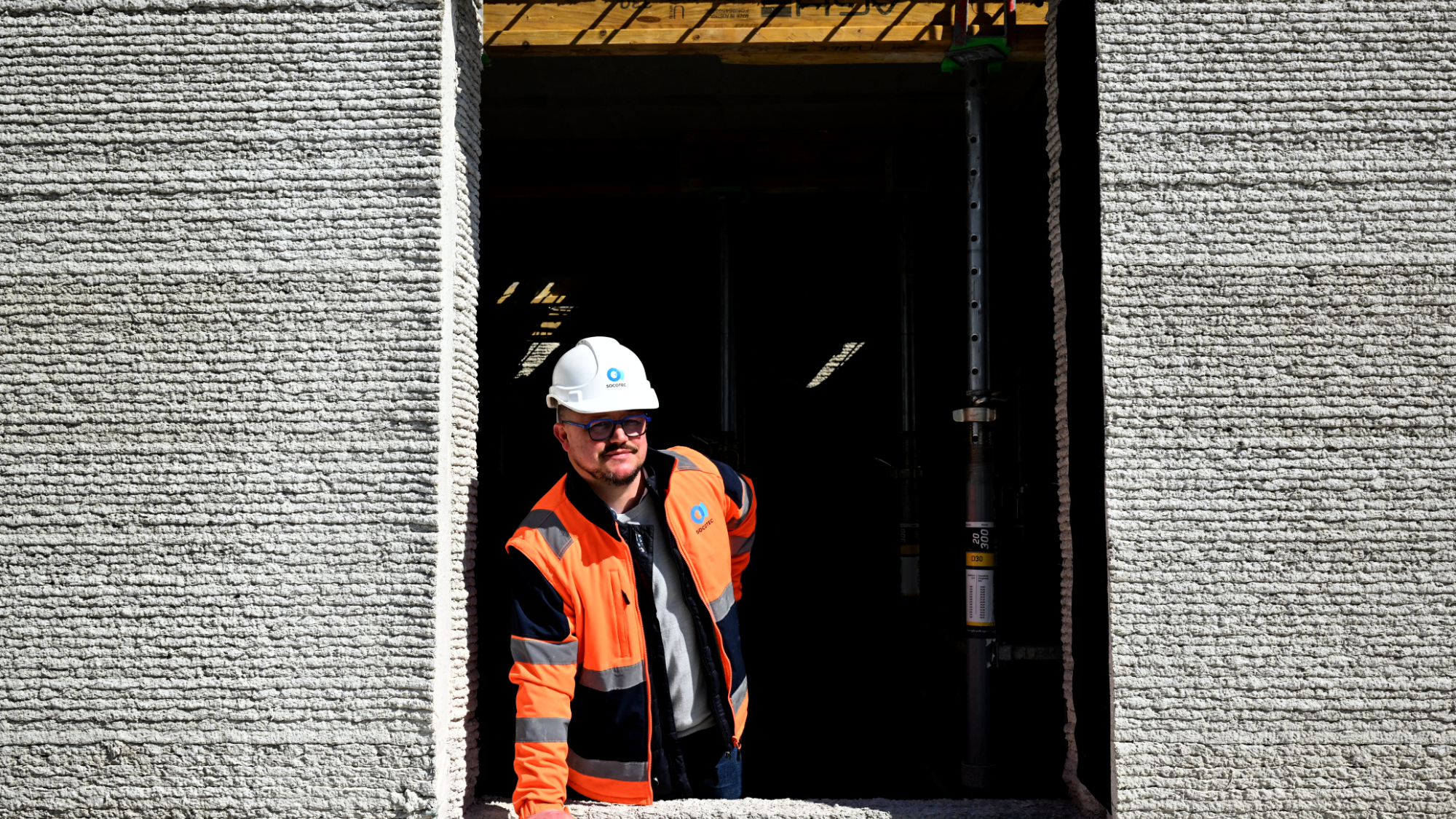3D-printed homes tested against earthquakes for the first time — 'Dramatic leap forward' hailed for potential use in earthquake-prone countries

The scope of 3D printing has gotten much bigger over the years, so much so that 3D-printed buildings are on track to become less of a novelty. A team of scientists from the UK, more specifically professors from the University of Bristol, have thankfully been hard at work developing a giant simulator capable of testing these 3D printed buildings for safety in the event of natural disasters like earthquakes by shaking them.
The simulator is essentially a huge table with mounting brackets to hold 3D-printed structures in place. The team can program a handful of movements, particularly horizontal motions, which can provide a look at how the structure will behave during sudden seismic activity. This work is being handled in the University of Bristol's Soil Foundation Structure Interaction Laboratory (SoFSI) and has been showcased by the BBC, which claims this project is the first of its kind.
Anastasios Sextos is a professor of earthquake engineering and confirmed that a major goal of this project is to help find a crossroads between affordability and safety when it comes to the future of 3D printed housing. Tests like these are crucial in helping designers create stable 3D designs that can be replicated safely for consumers who may not have the means to ensure the design integrity on their own.
Joking with BBC, Professor Sextos claims the team can test "anything that we can bolt to the table." So far, the simulator seems to be exclusively dedicated to testing 3D printed buildings. Once the simulator has completed the test, the information gathered can be shared with the original designers for further study.
Professor Sextos hopes that this work can help designers create safe and reliable building designs for people worldwide. Some countries are more likely to encounter earthquakes than others, and these tests make a huge difference for the people who rely on housing options like 3D-printed buildings.
There are some limitations with the simulator, mainly in the department of size. Speaking of giant 3D-printed buildings, you might like our recent story on the world's tallest 3D-printed building, found in Switzerland.
Follow Tom's Hardware on Google News to get our up-to-date news, analysis, and reviews in your feeds. Make sure to click the Follow button.
Get Tom's Hardware's best news and in-depth reviews, straight to your inbox.

Ash Hill is a contributing writer for Tom's Hardware with a wealth of experience in the hobby electronics, 3D printing and PCs. She manages the Pi projects of the month and much of our daily Raspberry Pi reporting while also finding the best coupons and deals on all tech.
-
hotaru251 concern I have is does it scale properly?Reply
a miniture table sized one doesnt nessisarily scale to a full size house.
weight, gravity, stress, etc may not scale the same against vibration and shaking. -
edzieba Reply
When appropriate scaling factors are applied yes. Shake-table testing for structures is at least a century old.hotaru251 said:concern I have is does it scale properly? -
lmcnabney Yeah, the vectors for quakes aren't just horizontal oscillations. This paper does a better job explaining it. Plenty of energy and motion on the vertical axis. Proximity to and depth of the epicenter creates that fluctuation. I question this because purpose-built structures for research aren't going to be even close to real-world development as concrete consistency will vary since the 'pour' is continuous. These structures don't use rebar and instead rely on the mix-in fiberglass which is garbage. My 2.5 year old patio pour is clear evidence of that.Reply -
Jabberwocky79 Reply
When you say "These structures" are you referring to 3D printed buildings? There is rebar tying the whole structure together on every layer. Steel reinforcements don't pop out of a bag of premix or a concrete truck either, so arguing that the mix is inferior is a bit null, isn't it? Whether it's poured out of a truck or poured out of a print head, it still requires reinforcement and sound building practices.lmcnabney said:These structures don't use rebar and instead rely on the mix-in fiberglass which is garbage. My 2.5 year old patio pour is clear evidence of that.
I don't know how the test will fare, but it will be interesting to see the results. Meanwhile, I see a lot of negativities toward additive construction and it's almost always due to misinformation or assumptions that don't match reality. -
Sam Hobbs What I want to know is how practical 3D printing is when a building needs to be repaired or improved upon. For those circumstances is it necessary to get a 3D printer back to the building?Reply -
USAFRet Reply
Some of them do have rebar in the walls.lmcnabney said:Yeah, the vectors for quakes aren't just horizontal oscillations. This paper does a better job explaining it. Plenty of energy and motion on the vertical axis. Proximity to and depth of the epicenter creates that fluctuation. I question this because purpose-built structures for research aren't going to be even close to real-world development as concrete consistency will vary since the 'pour' is continuous. These structures don't use rebar and instead rely on the mix-in fiberglass which is garbage. My 2.5 year old patio pour is clear evidence of that.
2PrCzW5tdV8View: https://www.youtube.com/watch?v=2PrCzW5tdV8 -
Jabberwocky79 Reply
That's a good question. The technology is too new to be able to answer that definitively. Time will tell. I would imagine that every circumstance will be different. If someone wanted a new addition to their home? Sure, they would need to set up a printer again if they wanted it to match. But there's nothing to say you HAVE to have the entire building printed. Most 3D printed buildings are still using conventional roofs and second floors. Additionally, not all 3D printed buildings stick with the raw appearance. Many are plastered smooth, and in such a case a new addition wouldn't look any different, regardless of the underpinnings.Sam Hobbs said:What I want to know is how practical 3D printing is when a building needs to be repaired or improved upon. For those circumstances is it necessary to get a 3D printer back to the building? -
lmcnabney Reply
The printed (concrete pumped in a thin stream like any 3D printer) uses no vertical rebar support. It does use framing to support overhangs in windows and doors. Watch it yourselfJabberwocky79 said:When you say "These structures" are you referring to 3D printed buildings? There is rebar tying the whole structure together on every layer. Steel reinforcements don't pop out of a bag of premix or a concrete truck either, so arguing that the mix is inferior is a bit null, isn't it? Whether it's poured out of a truck or poured out of a print head, it still requires reinforcement and sound building practices.
I don't know how the test will fare, but it will be interesting to see the results. Meanwhile, I see a lot of negativities toward additive construction and it's almost always due to misinformation or assumptions that don't match reality. -
Jabberwocky79 Reply
I've seen such videos many times, as I am a 3D printed construction enthusiast. Which is also why I took issue with your comment regarding the quality of the mix and lack of rebar. While it would be false to claim that every single 3D printed building is constructed the same way, the majority of them are tying an inner and outer wall together with horizontal reinforcement, and vertical reinforcement at the corners, pouring a solid inner column at those key locations. It's fine if people (maybe yourself?) don't like the idea of 3D printed construction, I just think it does the technology a disservice to make inaccurate, generalized statements. Don't worry, I do the exact same thing about other stuff, and I get called out for it as well. It was just your turn today :geek:lmcnabney said:The printed (concrete pumped in a thin stream like any 3D printer) uses no vertical rebar support. It does use framing to support overhangs in windows and doors. Watch it yourself
Maybe they do earthquake testing and find out it has been a horrible idea, maybe not. But let's not act like these buildings have the consistency of spaghetti held together with Elmer's glue. This tech has been in development for well over a decade with manufacturing and supply chains in place, and many proof-positive real-world examples currently in use.